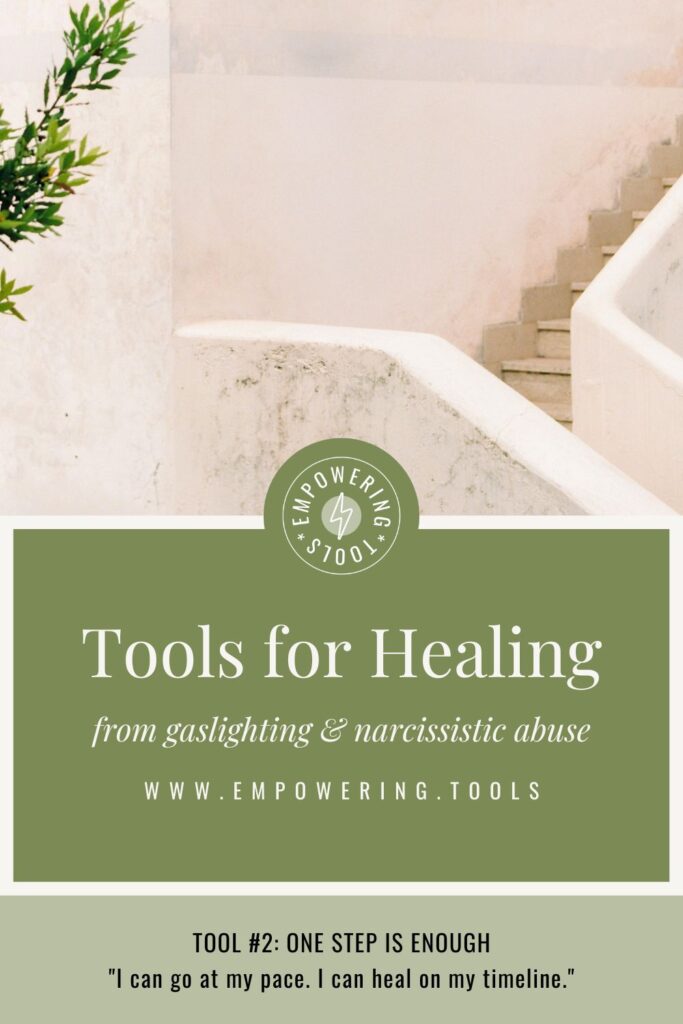SHARE

What are The Empowering Tools?
The Empowering Tools are a collection of methods and strategies designed by survivors for survivors. The methods feature small, doable techniques that can be used in a number of ways to help a survivor safely detach from an abuser and heal from coercive control, gaslighting, and narcissistic abuse. Because these types of abuse manipulate a survivor’s attachment, they require unique and powerfully flexible methods for healing. The Empowering Tools are built with that in mind.
What is The one step Tool?
Healing won’t happen in a day. It took time to tear you down, you’ll need a step-by-step process for building yourself back up. It’s ok to take single steps and then rest. Your reclamation and peace are worth the investment and you deserve to go at your pace.
Quick List about The one step Tool:
- Go at your pace. Heal along the pathway that works best for you. This may not always feel comfortable or comforting, but you can seek out the timing that suits your needs.
- You don’t have to know how to heal completely, just the next step in your healing process. By asking “What’s the tiniest next step I can take?”, you are giving yourself permission to go at your pace.
- Setting your pace is an act of incredible rebellion against the abuse you suffered.
- Avoid shaming yourself for “taking too long” to heal. Healing isn’t linear and it doesn’t happen along prescribed timelines.
Get Started Using The one step Tool
What’s the next tiniest step I can take in my healing?
Recovering from gaslighting and coercive control has the added challenge of feeling hostage to your own brain. The abuser may have conditioned you to shame yourself for getting things “wrong”. Many abusers condition victims to feel like they are taking too long to recover from an abusive tirade. The message of timing can be threaded through shame and guilt so much that a survivor will feel like they must rush to heal.
Healing happens as naturally as breathing, if we allow it to do so.
Healing takes time. And abusers love to manipulate that because it’s an easy target. The abuser wanted you to feel like you were constantly in the wrong so you’d be constantly on edge. They never wanted you to feel relief.
The abuse was terrible, so fighting a daily battle in your head after the abuse is over feels impossible to cope with.
You can give yourself the needed relief by focusing on your internal voice and consciously thinking to yourself, “I get to take my time to heal.”
One survivor – we’ll call her Julia – was shamed by her boyfriend for not healing quickly enough after he cheated on her. His abusive tirades blamed her for not forgiving him, but never once addressed his remorse for cheating.
Julia’s healing began with panic about how slowly things were going. It had been a few months since the break-up, shouldn’t she be ‘over him’ by now? And it didn’t help that her family and friends had the best of intentions in telling her she should be healing faster.
Consider: does Julia’s situation sound familiar at all? Is there anyone in your world who is rushing your healing?
the one step tool helps calm the panic of rushing
Julia needs to know she can go at her own pace. And recognizing that her panic comes from the abuse (and not reality) will help Julia as she cares for herself.
Here are a few “One Step” questions Julia can ask herself:
- Why do I feel the need to rush this healing?
- What benefit do my family and friends get from me healing ‘faster’?
- What messages do I need to hear about my healing?
- How can I deliver those messages to myself?
All of these questions are designed to help Julia slow things down and listen to her own needs.
if you don’t know the next step, listen inside
Listening inside is a step all its own. And sometimes? It’s the very best step you can take because you’re doing something the abuser never wanted you to do. It’s ok to breathe, it’s ok to pause, and it’s ok to rest.
It may feel like the pain of recovery is too great to slow down, but sometimes, slowing down and accepting your feelings can be the fastest path to relief.
Allow yourself to take a step, then rest. Take a step, then rest.
Go at your pace and heal on your own timeline.
You Aren’t Alone
It may feel like you are alone as you start this process, but there are many others in your shoes. If you’d like to connect with others in your situation, check out our supportive FB group, The Haven.
And for more information about the One Step Tool (and how to use it), check out our podcast, The Reclaimers.
We believe in you.
We believe in your future.
And we believe in your right to freedom from abuse.